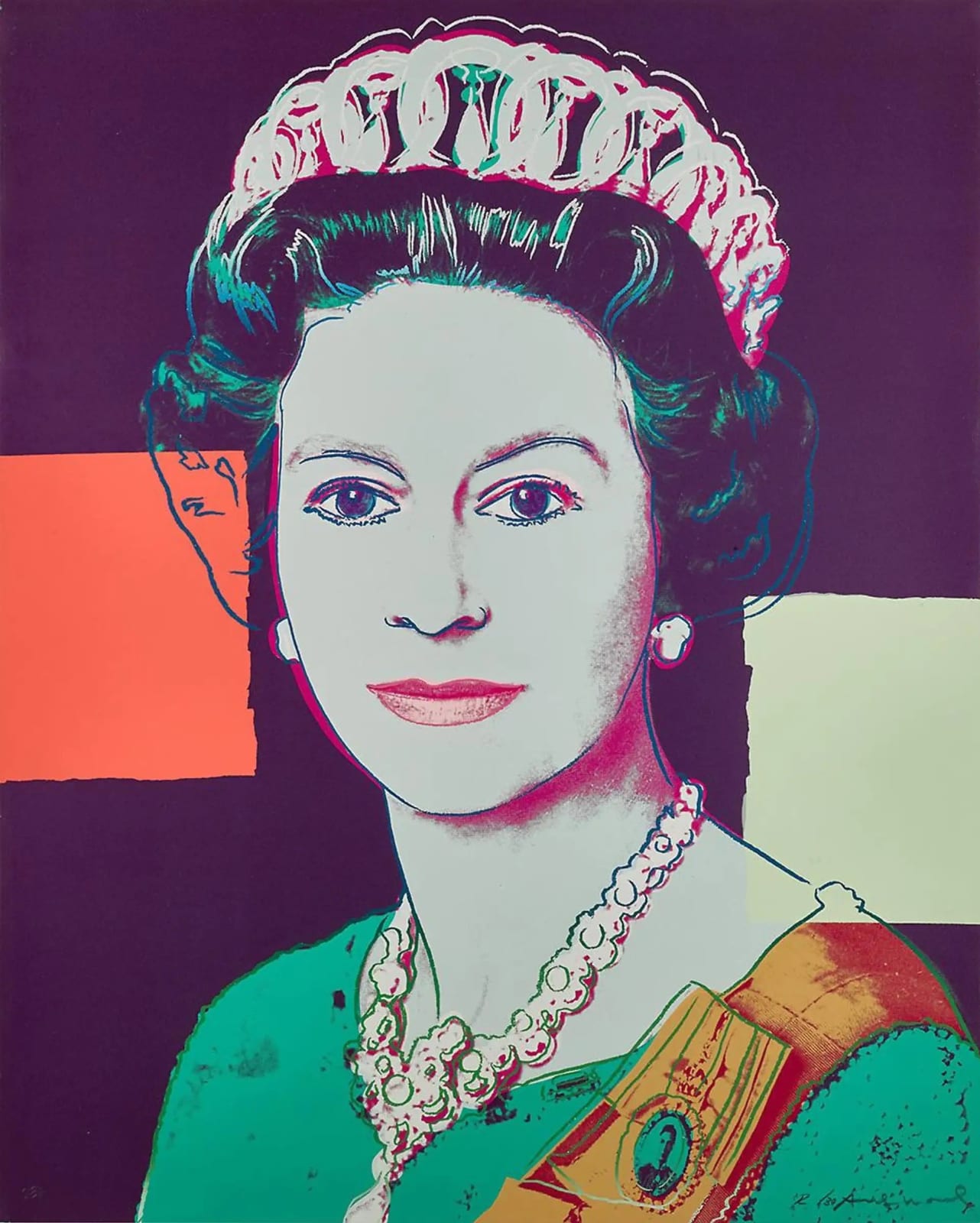
Andy Warhol
Signed and numbered in pencil.
Royal Edition
100 x 80 cm
Andy Warhol’s Queen Elizabeth II (FS.II 335a) Royal Edition is one of sixteen works in his celebrated Reigning Queens series, created just two years before his death in 1987. This vibrant collection features four ruling monarchs: Queen Elizabeth II of the United Kingdom, Queen Margrethe II of Denmark, Queen Beatrix of the Netherlands, and Queen Ntombi Twala of Swaziland. Each queen included in the portfolio held sovereign power in her own right—not as consorts, but as reigning heads of state. Warhol’s series explores themes of feminine authority, celebrity, and global recognition.
Warhol used official state and media photographs as source material for the series. For Queen Elizabeth II, he selected the iconic portrait taken by Peter Grugeon in 1975 and released during the queen’s Silver Jubilee celebrations in 1977. Warhol based four silkscreen prints on this single image, each differing in palette, layering, and composition, showcasing his fascination with visual variation and reproduction.
In Queen Elizabeth II 335a, Warhol places the queen against a striking purple background, which enhances the bold green of her ceremonial attire. Overlaying abstract color blocks—screened individually—create a fragmented, collage-like effect. This layering technique is quintessentially Warholian, drawing attention to both the constructed nature of public imagery and the artist’s own hand in manipulating it. Silk screening, a method Warhol adopted from commercial printing, allowed him to reproduce and reframe familiar images, transforming them into art objects while commenting on their ubiquity.
The Reigning Queens series exemplifies Warhol’s enduring preoccupation with repetition and mass production. As a pioneer of Pop Art, Warhol was deeply interested in how fame and media icons are manufactured, distributed, and consumed. His studio, famously dubbed “The Factory,” was a literal and symbolic site of artistic mass production. Through repeated imagery, Warhol blurred the lines between fine art, commerce, and advertising—a key tenet of his artistic philosophy.
In portraying monarchs—figures whose images appear widely on stamps, coins, and official regalia—Warhol emphasized the commodification of power. These portraits echo the mass-circulated state images while simultaneously glamorizing them through bold color schemes and stylized embellishments. By doing so, Warhol not only reflects on the ceremonial aspects of monarchy but also equates royal image-making with celebrity culture.
The relationship between fame, femininity, and influence is a recurring theme throughout Warhol’s career. From Marilyn Monroe and Jackie Kennedy to Liza Minnelli and Debbie Harry, Warhol created a pantheon of iconic women whose public images captivated the world. In many of these works, Warhol employed similar visual strategies—vibrant colors, simplified forms, and accentuated features. In Queen Elizabeth II 335, these stylistic choices are especially evident. Her lips are rendered in a vivid pink, while bright blue detailing around her eyes mimics bold eyeliner, transforming the queen’s portrait into a stylized image akin to fashion or cosmetics advertising.
Though best known for his depictions of Hollywood celebrities, Warhol also explored political imagery throughout his career. In addition to the Reigning Queens series, he created portraits of public figures like John F. Kennedy, Mao Zedong, and Vladimir Lenin. His political commissions included a portrait for Jimmy Carter’s 1976 presidential campaign. With these works, Warhol elevated political figures to celebrity status, questioning the role of mass media in shaping both political and pop-cultural identities.
Despite its visual glamour, Queen Elizabeth II 335a is more than an exercise in aesthetics. It is a complex meditation on visibility, authority, and iconography. By reimagining a formal royal portrait through the lens of Pop Art, Warhol invites viewers to reconsider how images of power are created, replicated, and consumed in modern society. The result is a work that is simultaneously reverent and irreverent—celebrating the monarchy’s grandeur while dissecting the mechanics of its image.
The Reigning Queens portfolio stands as one of Warhol’s largest series in scope, comprising four portraits of each monarch for a total of sixteen prints. Despite its scale, the edition size was limited, making the series particularly appealing to collectors. Today, these prints remain highly sought after not only for their aesthetic value but also for their historical significance—capturing the intersection of pop culture, politics, and femininity at a pivotal moment in contemporary art.
In Queen Elizabeth II 335a, Warhol encapsulates a powerful fusion of tradition and modernity. He transforms a symbol of statehood into a Pop icon, bridging the ceremonial gravitas of monarchy with the glossy allure of celebrity. Through color, repetition, and composition, Warhol’s queen is not merely depicted—she is reimagined, stylized, and immortalized in a way only Pop Art can achieve.
For more information on Andy Warhol's Queen Elizabeth II F.S II 335a Royal Edition for sale or to buy Queen Elizabeth II FS.II 335a Royal Edition, contact our galleries using the form below.